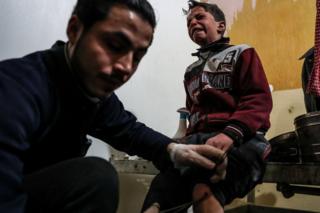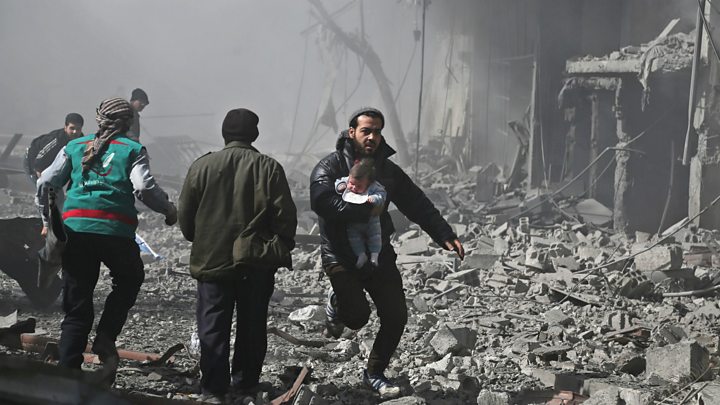 Image copyright
Image copyright
EPA
Opposition activists said Douma was one of at least 10 Eastern Ghouta towns hit on Tuesday
At least 50 civilians have reportedly been killed in fresh Syrian government attacks on the besieged rebel-held Eastern Ghouta region outside Damascus.
First responders from the Syria Civil Defence said air and artillery strikes on the town of Marj left 24 dead there.
A monitoring group said 127 civilians were killed on Monday in the deadliest day for three years in the enclave, where some 393,000 people are trapped.
The UN has warned that the situation there is “spiralling out of control”.
It has said the indiscriminate bombardment of the Eastern Ghouta must stop immediately and called for a ceasefire to allow humanitarian aid to be delivered and hundreds of critically sick and wounded patients to be evacuated.
What’s happening on the ground?
Activists said at least 10 towns and villages across the region came under renewed bombardment by the Syrian government and its allies on Tuesday.

The Syria Civil Defence, whose rescue workers are commonly known as the White Helmets, said five women and children were among the 24 people killed in Marj. Another 10 civilians died as a result of strikes on Arbin and Misraba, it added.
The Local Co-ordination Committees, an opposition activist network, reported that 77 civilians had been killed, while the Syrian Observatory for Human Rights, a UK-based monitoring group, put the death toll at 50, including 13 children.
It said 194 people had now been killed and 850 wounded since the government bombardment intensified on Sunday night.
Syrian state television meanwhile reported that at least two people living in government-controlled areas of eastern Damascus were killed and 13 others wounded by shells fired by rebels based in the Eastern Ghouta.
The Syrian military has not commented on the reports from the Eastern Ghouta, but said it carried out “precision strikes” on areas from which the shells were launched.
How bad is the situation in the enclave?
A local doctor told the Union of Medical Care and Relief Organisations (UOSSM), which supports medical facilities in the Eastern Ghouta, that it was “catastrophic”.
“People have nowhere to turn,” he said. “They are trying to survive but their hunger from the siege has weakened them significantly.”
The UN’s Regional Humanitarian Co-ordinator for the Syria Crisis, Panos Moumtzis, said on Monday that many residents had “little choice but to take shelter in basements and underground bunkers with their children”.
He added that with the government only allowing one humanitarian convoy into the Eastern Ghouta since late November, there also were severe shortages of food.
A bundle of bread now costs close to 22 times the national average and 11.9% of children under five years old are acutely malnourished – the highest rate recorded in Syria since the start of the civil war in 2011.

Mr Moumtzis urged all parties to strictly adhere to their obligations under international humanitarian law to take all feasible measures to protect civilians.
“It’s imperative to end this senseless human suffering now. Such targeting of innocent civilians and infrastructure must stop now,” he added.
The UN children’s agency issued a “blank statement”, saying its officials “no longer have the words to describe children’s suffering and our outrage”.
The Eastern Ghouta is the last major rebel stronghold near Damascus. It is dominated by the Islamist faction Jaish al-Islam. But Hayat Tahrir al-Sham, a jihadist alliance led by al-Qaeda’s former affiliate in Syria, also operates there.
The region has been designated a “de-escalation zone” by Russia and Iran, the government’s main allies, along with Turkey, which backs the rebels. But hostilities intensified in mid-November, when the Syrian military stepped up air and artillery attacks on the enclave in response to a rebel offensive.
Why has the government intensified its bombardment?
By Sebastian Usher, BBC Middle East analyst
The Syrian government is taking its tactic of attrition to the extreme in the Eastern Ghouta.
That strategy has finally brought other rebel holdouts to submission, most notably Aleppo. The intensity of bombardments from land and air appear aimed at devastating every last vestige of the makeshift infrastructure that has just about been sustaining life for the area’s 390,000 inhabitants.
The irony of the region being designated a “de-escalation zone” has never been so stark. International outrage and calls for a ceasefire are rising, but President Assad has been here before.
With Russia and Iran calling the shots in Syria, he seems to feel sufficiently emboldened to try to crush the last rebel bastion near Damascus, whatever the cost in civilian lives.
Syria war: Fresh strikes on besieged Eastern Ghouta kill dozens}

